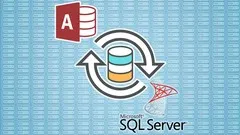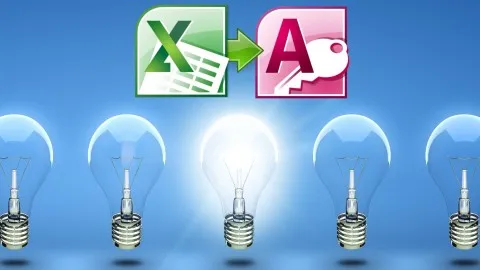
Free Microsoft Access Tutorial - The Beginning Guide to Microsoft Access 2013 
This free Microsoft Access Tutorial is the perfect starting point for learning how to use Microsoft Access 2013. Learn how to create tables, use form fields, create queries, use query criteria and parameter queries, and create and alter reports using layout and design views. With this tutorial, you'll be able to quickly and easily understand the basics of Microsoft Access 2013. ▼
ADVERTISEMENT
Course Feature
![]() Cost:
Cost:
Free
![]() Provider:
Provider:
Udemy
![]() Certificate:
Certificate:
No Information
![]() Language:
Language:
English
![]() Start Date:
Start Date:
Self Paced
Course Overview
❗The content presented here is sourced directly from Udemy platform. For comprehensive course details, including enrollment information, simply click on the 'Go to class' link on our website.
Updated in [May 25th, 2023]
This course provides an introduction to Microsoft Access 2013. It covers the basics of creating and managing a database, including understanding tables and how they are used in a database, navigating form fields and entering data, creating queries to search for records in tables, using query criteria and parameter queries to pick specific records in tables, and using layout and design views to create and alter reports. By the end of the course, users will have a better understanding of how to use Microsoft Access 2013.
[Applications]
The application of this course can be seen in the ability to create and manage databases in Microsoft Access 2013. Users can create tables, forms, queries, and reports to store and manipulate data. Additionally, users can use query criteria and parameter queries to search for specific records in tables. Finally, users can use layout and design views to create and alter reports.
[Career Paths]
1. Database Administrator: Database Administrators are responsible for the design, implementation, maintenance, and security of an organization's databases. They ensure that the databases are running efficiently and securely, and they are also responsible for troubleshooting any issues that may arise. As technology advances, Database Administrators must stay up to date on the latest trends and technologies in order to remain competitive in the job market.
2. Data Analyst: Data Analysts are responsible for analyzing data and providing insights to help organizations make better decisions. They use a variety of tools and techniques to analyze data, such as statistical analysis, machine learning, and data mining. Data Analysts must have strong analytical and problem-solving skills, as well as the ability to interpret and communicate data effectively.
3. Business Intelligence Developer: Business Intelligence Developers are responsible for developing and maintaining business intelligence solutions. They use a variety of tools and techniques to create reports, dashboards, and other visualizations that help organizations make better decisions. Business Intelligence Developers must have strong technical skills, as well as the ability to interpret and communicate data effectively.
4. Database Developer: Database Developers are responsible for designing, developing, and maintaining databases. They use a variety of tools and techniques to create databases that are efficient, secure, and reliable. Database Developers must have strong technical skills, as well as the ability to interpret and communicate data effectively. As technology advances, Database Developers must stay up to date on the latest trends and technologies in order to remain competitive in the job market.
[Education Paths]
1. Bachelor of Science in Computer Science: This degree path focuses on the fundamentals of computer science, such as programming, software engineering, and computer architecture. It also covers topics such as artificial intelligence, data structures, and algorithms. With the increasing demand for technology professionals, this degree path is becoming increasingly popular and is a great way to gain the skills needed to work with Microsoft Access.
2. Bachelor of Science in Information Technology: This degree path focuses on the application of technology to solve business problems. It covers topics such as database management, web development, and network security. With the increasing demand for technology professionals, this degree path is becoming increasingly popular and is a great way to gain the skills needed to work with Microsoft Access.
3. Master of Science in Information Systems: This degree path focuses on the application of technology to solve business problems. It covers topics such as database management, web development, and network security. It also covers topics such as data mining, data warehousing, and business intelligence. This degree path is becoming increasingly popular as businesses are looking for professionals with the skills to manage and analyze large amounts of data.
4. Master of Science in Computer Science: This degree path focuses on the fundamentals of computer science, such as programming, software engineering, and computer architecture. It also covers topics such as artificial intelligence, data structures, and algorithms. This degree path is becoming increasingly popular as businesses are looking for professionals with the skills to develop and maintain complex software systems.
Pros & Cons

Clear explanation

Fast and to the point

Step by step instructions

Highly recommended

Very useful

Mouse not recorded

Difficulty finding downloads

Bought not covered
Course Provider

Provider Udemy's Stats at AZClass
Discussion and Reviews
0.0 (Based on 0 reviews)
Explore Similar Online Courses

Learn Basics of Content Analysis and Content Strategy

Scripting practices with Python and Blender

Python for Informatics: Exploring Information

Social Network Analysis

Introduction to Systematic Review and Meta-Analysis

The Analytics Edge

DCO042 - Python For Informatics

Causal Diagrams: Draw Your Assumptions Before Your Conclusions

Whole genome sequencing of bacterial genomes - tools and applications

Upsize Your MS Access Business Information to MS SQL Server

Intro to Access - Microsoft Access Basics for Beginners


Start your review of Free Microsoft Access Tutorial - The Beginning Guide to Microsoft Access 2013